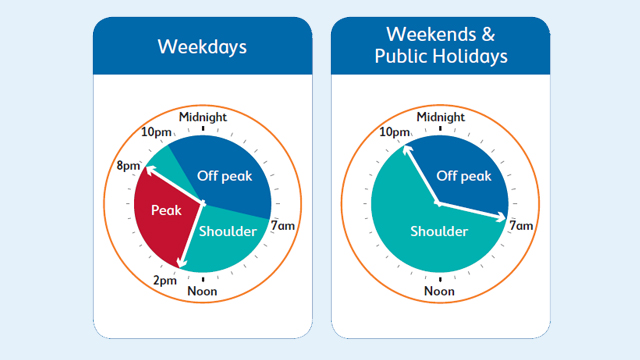There are many important considerations when it comes to installing a battery storage system for your home. One of the most important ones is whether or not to switch electricity tariffs from a flat rate to a time-of-use rate. Which one will provide the most benefit once you have batteries installed?
When talking about retail electricity prices, flat rate tariffs are just that – you pay a set amount for every unit (kilowatt-hour, or kWh) of energy that you purchase from the grid. It doesn’t matter when you use the electricity – the rate stays roughly the same.
Time of use (TOU) tariffs, on the other hand, charge households different rates depending on the time of day that they use their electricity. The image below (from network company Ausgrid), shows how TOU is broken down throughout the day. (Keep in mind that the timing of TOU tariffs differs depending on your network company.)
 An example of time of use tariff schedules. Image via Ausgrid.
An example of time of use tariff schedules. Image via Ausgrid.
‘Peak’ rates are the most expensive, ‘shoulder’ rates slightly less expensive, and ‘off-peak’ rates generally lower than flat rate tariffs from the same retailer. This means that if you manage to purchase less energy during peak & shoulder times and more during off-peak times, there is much more potential for saving money than on a flat rate tariff – especially if your peak rates are significantly higher than your shoulder & off-peak rates
Battery storage is the key to unlocking this potential. Batteries can help you to meet more of your peak demand with your solar energy by storing any daytime excess (which would otherwise be ‘wasted’ into the grid) for later use. It also unlocks the possibility of tariff ‘arbitrage’ – essentially buying energy when it’s cheap and storing it in batteries for later use. According to our own indicative analysis, payback on a battery system can be at least 2 years faster using tariff arbitrage than without it.
The combination of these two possibilities spells significant potential savings. You can see if TOU might be right for your home on solar+storage using our Solar Plus Battery Storage System Sizing and Payback Calculator.
You can also instantly compare battery storage system & solar prices by requesting a Solar Quote Comparison – simply complete the form to the right of this page (click ‘battery’ if you already have a solar PV system).
Top image via Ausgrid.
© 2016 Solar Choice Pty Ltd
- Solar Panel Costs: Solar Choice Price Index | April 2025 - 1 April, 2025
- Solar Panels For Homes – All You Need to Know About Solar Systems - 18 March, 2025
- Best NSW Solar Feed-In Tariffs - 17 March, 2025
I already have my HWS on off peak rate (currently 12.5c/kWh ) with the flat rate at 22.3c/kWh. Is it possible to have the battery charge overnight on the off peak tariffs and topped up with solar during the day. My retailer is Origin and supplier is Energex in SEQld.
Hi Pat,
In theory, yes – this is known as tariff arbitrage and it’s widely recognised as one of the strategies for getting the most out of batteries. Check with your electricity retailer and also talk to an installer about it.
If you’re interested, you can compare quotes on batteries from installers in our network by filling out the quote comparison request form to the right of this page (click ‘Battery Storage Only’).
Hi
Would getting battery storage effect my FIT contract in WA?
Glenn
Hi Glenn,
I’ve placed an enquiry with WA Department of Finance and will get back to you with an answer as soon as they respond.